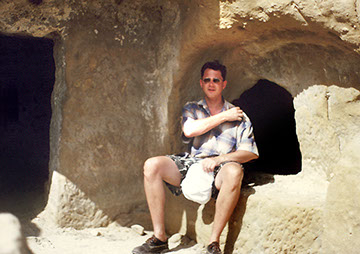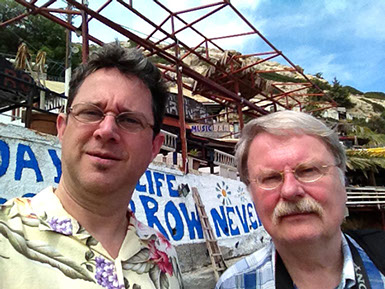
ABOUT THIS SITE
In 1996 I visited Matala for the first time. I was told that in the sixties dropouts and hitchhikers from Europe and the USA settled here and formed a community in the caves.
 I don't know why, but this somehow intrigued me and I wanted to know more about it. The locals couldn’t give much information. It seemed it was something they’d rather not talk about.
I don't know why, but this somehow intrigued me and I wanted to know more about it. The locals couldn’t give much information. It seemed it was something they’d rather not talk about.
Back at home I searched the internet, sites and discussion groups. But still I couldn’t find anything substantial (only something about Joni Mitchell).
I thought: ‘If this existed, it must have been an impressive time for the people who were there. There must be pictures and stories. If I can’t find anything about it, it’s probably not true; it must be a hoax.’
I gave up the online search.
May 2005 I was browsing through some very old LIFE-magazines (European edition). My parents gave them to me; I kept them for a long time, but now I was cleaning out my storage space. Before I would throw them away I took one more good look at them.
And there it was! In the August 19, 1968 issue: seven pages about the Matala colony with exactly the kind of pictures I was looking for. The article is written by Thomas Thompson and photography is by Denis Cameron.
I scanned the article and split it up into comprehensive pages for a small website (bandwith was a problem in those days). And I wrote 2 lines, asking people to send their stories. In 2007, Ria from Belgium was the first to respond.
2010
5 years passed and I came in contact with a few friendly people willing to share their Matala experience.
I am not, nor have I ever been a flower child, but I am interested in simple ways of living, close to nature and human values. I was in Matala only in 1996 for half a day.
Slowly I realised why I was so intrigued by the Matala caves and the notion that they were inhabited in the sixties and seventies.
2011
It is march and I am so very happy with the book by Arn Strohmeyer.
The book is mostly the fruit of Arn’s labour and that of all the flower children who wrote their stories and sent pictures.
But, apart from that, I like to look at the book as the crowning glory of my quest for the Matala experience that started in 1996.
2012
And just when you think things can't get any better, they get even better. The book launch has developed into an annual three-day-festival, the biggest thing Matala has ever seen.
I just returned from the second festival.
I met many kind and interesting people and had a wonderful time. Matala has changed a lot, but it still is a special place with its own unique vibe.
I returned to Matala in ’13, ’14 and ’15 during the festival and a few days before and after.
Dutch newspaper article about Matala, this site and my trip to the festival in 2012.
Elzo Smid